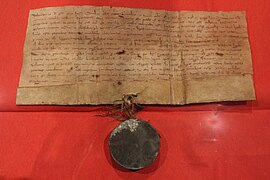This articleneeds additional citations forverification.(September 2024) |
Town privilegesorborough rightswere important features of European towns during most of the second millennium.[1][2]The city law customary inCentral Europeprobably dates back toItalianmodels, which in turn were oriented towards the traditions of theself-administrationofRomancities.


Judicially, aborough(orburgh) was distinguished from the countryside by means of acharterfrom the rulingmonarchthat defined itsprivilegesandlaws.[2][3][4]Common privileges involvedtrade(marketplace, the storing of goods, etc.) and the establishment ofguilds.Some of these privileges were permanent and could imply that the town obtained the right to be called aborough,hence the term "borough rights" (German:Stadtrecht;Dutch:stadsrechten). Some degree ofself-government,representation bydiet,andtax-reliefcould also be granted.[1][2]Multiple tiers existed; for example, inSweden,the basic royal charter establishing a borough enabled trade, but not foreign trade, which required a higher-tier charter grantingstaple right.
See also
edit- City rights in the Low Countries
- City status in the United Kingdom
- Confoederatio cum principibus ecclesiasticis
- German town law
- Zipser Willkür
- Imperial free city
- Kulm law
- Lübeck law
- Magdeburg rights
- Market town
- Royal free citiesin theKingdom of Hungary
- Scottish Burgh
- Town privileges in Norway
- Town privileges in Sweden
References
edit- ^abBlockmans, Wim; Hoppenbrouwers, Peter (3 February 2014). "Towns and the Urbanisation of Medieval Society".Introduction to Medieval Europe 300–1500.Routledge.pp. 305–312.ISBN978-1-317-93425-7.
- ^abcWhittock, Martyn (7 February 2013).A Brief History of Life in the Middle Ages.Little, Brown Book Group.ISBN978-1-4721-0766-4.
- ^Dymond, Dorothy (6 November 2023) [Initially published in 1929].An Introduction to Medieval History.Taylor & Francis.ISBN978-1-003-82466-4.
- ^Heibaut, Dirk; Heikki, Pihlajamäki (28 December 2023). "High and Late Middle Ages (1100-1500)".A Companion to Western Legal Traditions: From Antiquity to the Twentieth Century.Brill.pp. 205–206.ISBN978-90-04-68725-7.